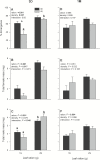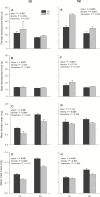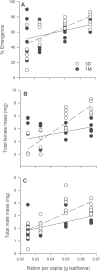Conditioning of Leaf Detritus Modulates Density-Dependent Growth of Aedes triseriatus Larvae (Diptera: Culicidae)
- PMID: 29190386
- PMCID: PMC5850855
- DOI: 10.1093/jme/tjx209
Conditioning of Leaf Detritus Modulates Density-Dependent Growth of Aedes triseriatus Larvae (Diptera: Culicidae)
Abstract
Ration of food per capita of larval population is widely thought to limit mosquito production from container habitats, directly reflecting resource limitation. In this study, the importance of density-dependent resource limitation on larval Aedes triseriatus (Say) (Diptera: Culicidae) depended on the degree of microbial conditioning of senescent leaf detritus in surrogate tree holes. Density and ration strongly affected emergence, total female mass, and mean female mass of populations grown on leaves that had conditioned for 3 d, but had less impact when larval populations were grown on leaves that had conditioned for 1 mo. Ration per capita was a stronger predictor (50-94% of the variance) of all growth parameters measured for populations grown on leaves conditioned for 3 d compared with 1 mo (2-66% of variance), with the exception of development time. Larvae grew faster and to a larger body size on leaves conditioned for 3 d at low densities of larvae and a higher ration per capita. However, populations grown on leaves conditioned for 1 mo produced equal or more total mass and individuals of higher average mass than when grown on leaves conditioned for 3 d in treatments with low ration per capita. Well-conditioned detritus, representing the degree of microbial colonization of the organic material, must reflect the typical condition in tree holes with unconditioned leaves atypical. Therefore, results of this study suggest that experiments using well-conditioned leaves better estimate growth responses, including moderated density dependence and less importance of ration per capita, than experiments using unconditioned detritus.
Figures





Similar articles
-
Development and survival of immature Aedes albopictus and Aedes triseriatus (Diptera: Culicidae) in the laboratory: effects of density, food, and competition on response to temperature.J Med Entomol. 2000 Jan;37(1):40-52. doi: 10.1603/0022-2585-37.1.40. J Med Entomol. 2000. PMID: 15218906
-
The significance of ratios of detritus types and micro-organism productivity to competitive interactions between aquatic insect detritivores.J Anim Ecol. 2007 Nov;76(6):1105-15. doi: 10.1111/j.1365-2656.2007.01297.x. J Anim Ecol. 2007. PMID: 17922707 Free PMC article.
-
Leaf-associated bacterial and fungal taxa shifts in response to larvae of the tree hole mosquito, Ochlerotatus triseriatus.Microb Ecol. 2008 May;55(4):673-84. doi: 10.1007/s00248-007-9310-6. Microb Ecol. 2008. PMID: 17899246 Free PMC article.
-
What Can Larval Ecology Tell Us About the Success of Aedes albopictus (Diptera: Culicidae) Within the United States?J Med Entomol. 2016 Sep;53(5):1002-12. doi: 10.1093/jme/tjw046. Epub 2016 Jun 28. J Med Entomol. 2016. PMID: 27354437 Review.
-
[Description of Aedes (Ochlerotatus) coluzzii n. sp. (Diptera, Culicidae), twin A species of the detritus complex].Parassitologia. 1998 Sep;40(3):353-60. Parassitologia. 1998. PMID: 10376297 Review. French.
Cited by
-
Survival-Larval Density Relationships in the Field and Their Implications for Control of Container-Dwelling Aedes Mosquitoes.Insects. 2022 Dec 23;14(1):17. doi: 10.3390/insects14010017. Insects. 2022. PMID: 36661946 Free PMC article.
References
-
- Arsuffi T. L., and Suberkropp K.. 1985. Selective feeding by stream caddisfly (Trichoptera) detritivores on leaves with fungal-colonized patches. Oikos 45: 50–58.
-
- Barlocher F., and Kendrick B.. 1975. Leaf-conditioning by microorganisms. Oecologia 20: 359–362. - PubMed
-
- Carpenter S. R. 1982. Comparisons of equations for decay of leaf litter in tree-hole ecosystems. Oikos 39: 17–22.
-
- Carpenter S. R. 1983. Resource limitation of larval treehole mosquitos subsisting on beech detritus. Ecology 64: 219–223.
-
- Carpenter S. R. 1996. Microcosm experiments have limited relevance for community and ecosystem ecology. Ecology 77: 677–680.
Publication types
MeSH terms
Grants and funding
LinkOut - more resources
Full Text Sources
Other Literature Sources

